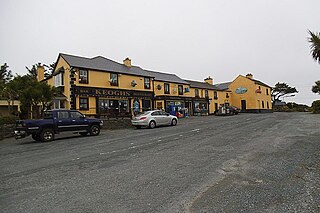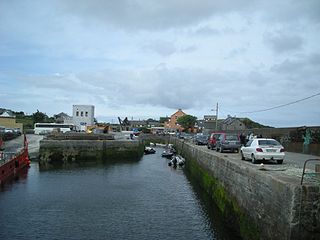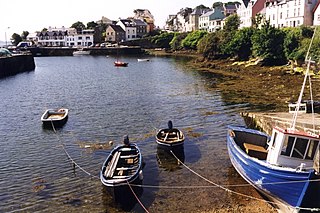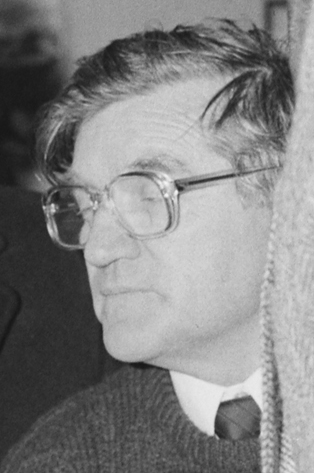
Galway Bay is a bay on the west coast of Ireland, between County Galway in the province of Connacht to the north and the Burren in County Clare in the province of Munster to the south; Galway city is on the northeast side. The bay is about 50 kilometres (30 mi) long and from 10 kilometres (6 mi) to 30 kilometres (20 mi) in breadth. The Aran Islands are to the west across the entrance and there are numerous small islands within the bay. To the west of Galway, the rocks are granite but to the south they are limestone.

Connemara is a region on the Atlantic coast of western County Galway, in the west of Ireland. The area has a strong association with traditional Irish culture and contains much of the Connacht Irish-speaking Gaeltacht, which is a key part of the identity of the region and is the largest Gaeltacht in the country. Historically, Connemara was part of the territory of Iar Connacht. Geographically, it has many mountains, peninsulas, coves, islands and small lakes. Connemara National Park is in the northwest. It is mostly rural and its largest settlement is Clifden.

Clifden is a coastal town in County Galway, Ireland, in the region of Connemara, located on the Owenglin River where it flows into Clifden Bay. As the largest town in the region, it is often referred to as "the Capital of Connemara". Frequented by tourists, Clifden is linked to Galway city by the N59.

Omey Island is a tidal island situated near Claddaghduff on the western edge of Connemara in County Galway, Ireland. From the mainland the island is almost hidden. It is possible to drive or walk across a large sandy strand to the island by following the arrowed signs. At high tide, the water is deep enough to cover a car.

Ballyconneely is a village and small ribbon development in west Connemara, County Galway Ireland.

Inishbofin is a small island off the coast of Connemara, County Galway, Ireland. Inishbofin has around 180 inhabitants and is a tourist destination.

Cleggan is a fishing village in County Galway, Ireland. The village lies 10 km (7 mi) northwest of Clifden and is situated at the head of Cleggan Bay.

Roundstone is a village on the west coast of Ireland, in the Connemara region of County Galway. Lying opposite the island of Inishnee on Roundstone Bay, by road it is 76 kilometres (47 mi) northwest of Galway and 18 kilometres (11 mi) southeast of Clifden. Known as a haven for people in the creative arts, it hosts an annual regatta in July.

The Galway hooker is a traditional fishing boat used in Galway Bay off the west coast of Ireland. The hooker was developed for the strong seas there. It is identified by its sharp, clean entry, bluff bow, marked tumblehome and raked transom. Its sail plan consists of a single mast with a main sail and two foresails. Traditionally, the boat is black and the sails are a dark red-brown.

Carna is an area in Connemara, County Galway, Ireland. It is located on the country's west coast in the Gaeltacht, about 50 km west of Galway city. Carna is an extremely small area, but as a focal point for the surrounding areas, it contains a Garda Síochána station, a Health Centre including a Rapid Response Ambulance, and an Irish Coastguard lifeboat. Carna is not located close to any villages. The population dramatically dropped from the previous average of 8,000 before the Great Famine. The age of the average resident is significantly higher than the Irish national average.

Claddaghduff is a village in County Galway, Ireland. It is located northwest of Clifden, the gateway to Omey Island.

Pól Ó Foighil was an Irish politician and activist for Irish-speaking, coastal and island communities. A teacher turned co-operative manager, he was an active member of the Fine Gael party, and as a long-serving councillor he was the party's only elected representative in the Connemara Gaeltacht for two decades. He also served as a senator from 1989 to 1993.

Inisheer Aerodrome is located on the island of Inisheer, one of the Aran Islands in Galway Bay off the coast of County Galway, Ireland. This aerodrome is licensed by the Aeronautical Services Department of the Irish Aviation Authority.

Inishmaan Aerodrome is located on the island of Inishmaan, one of the Aran Islands in Galway Bay off the coast of County Galway, Ireland. This aerodrome is licensed by the Aeronautical Services Department of the Irish Aviation Authority.
Gregory Ceannanach, early Irish missionary, fl. c. 490-500?

The Wild Atlantic Way is a tourism trail on the west coast, and on parts of the north and south coasts, of Ireland. The 2,500 km driving route passes through nine counties and three provinces, stretching from County Donegal's Inishowen Peninsula in Ulster to Kinsale, County Cork, in Munster, on the Celtic Sea coast.

Cleggan Bay is a natural ocean bay in County Galway, Republic of Ireland.

Renvyle or Rinvyle is a peninsula and electoral division in northwest Connemara in County Galway, close to the border with County Mayo in Ireland.

Ballynakill Lough is a lake in Connemara, County Galway, Ireland. The lake is fed by a short stream connected to the nearby Atlantic Ocean. Tooreen Bog is located on the lakes south coast. The village of Cleggan is located to the west.
Rossadilisk is a townland in the civil parish of Omey in County Galway Ireland.


















